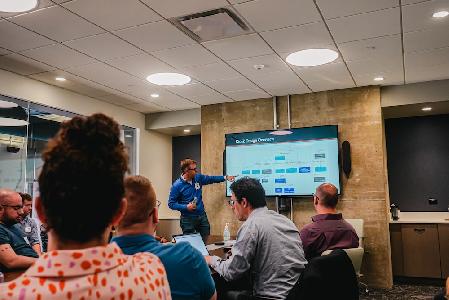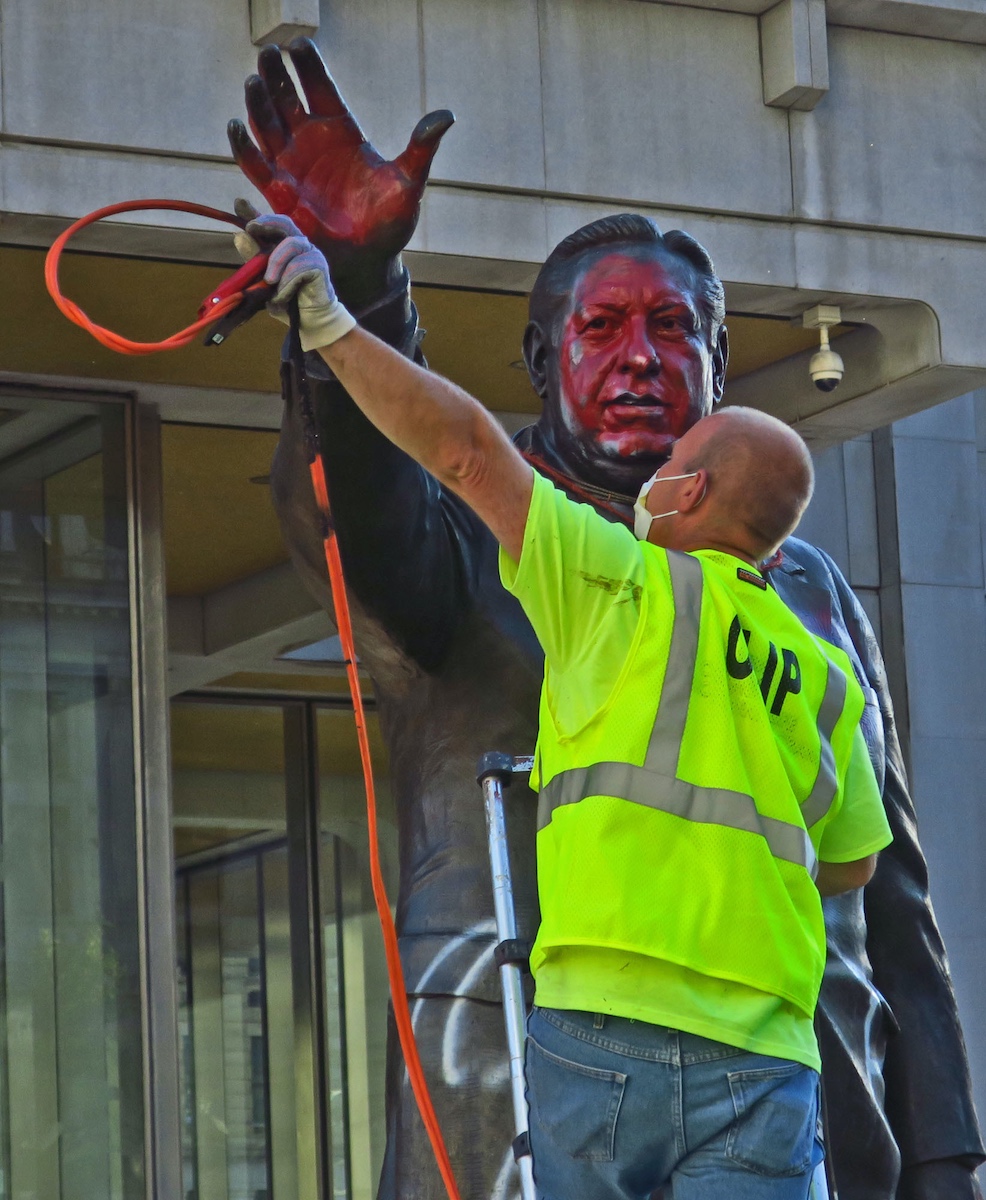One historic moment you might be grasping for is Aug. 28, 1964.
Like this past weekend, it’s a mistake to wave away that August evening as petty vandalism that erupted from a single incident. Back then a police stop at 22nd and Columbia Avenue in North Philadelphia led to collective action and later descended into vandalism and looting. This week, peaceful protests in response to the grotesque video of a white police officer killing George Floyd, an unarmed Black man, later descended into vandalism and looting and ATM explosions, in Philadelphia and across the country.
In both cases, the broken glass is a consequence, not the core issue.
https://twitter.com/BryantRiley_/status/1266870241444925442
A year after the destruction of Columbia Avenue, local NAACP leader Cecil B. Moore, after whom that stretch of Columbia Avenue is now named, led extended protests that were joined by Dr. Martin Luther King Jr. to open up Girard College, which was still maintaining its charter to serve only white children. Though Philadelphia saw other large-scale actions in 1967 and 1968, that summer evening in 1964 was a defining moment in this city’s contribution to societal change, shook unevenly and incompletely by fits of rage and political alliance.
Civic and business leaders had an opportunity to listen and learn in August 1964. Mostly, they did not.
This week has featured some of the largest peaceful protests in this city’s modern history; others have been escalated by police violence — or vigilante groups. This weekend, different commercial corridors took the brunt of the ensuing destruction — first the retail-rich blocks of Walnut and Chestnut streets leading to Rittenhouse Square Park on Saturday and then brought to neighborhoods, including 52nd Street in West Philadelphia and along Kensington Avenue in the River Wards. Collectively it has resulted in some of the first citywide curfews since that 1964 summer — not including youth-only ones in response to flash mobs.
But don’t let vandalism define your understanding of this moment, just like you do not understand the 1960s for its vandalism. Instead engage with what has happened and what needs to be done.
Aerial view shows massive march extending multiple city blocks in Philadelphia, one of numerous protests over the death of George Floyd that are roiling the nation. https://t.co/s5uDBXwHyA pic.twitter.com/rhbJ29iLYv
— ABC News (@ABC) June 1, 2020
The City of Philadelphia, like other local governments around the country, is facing a massive budget shortfall, from reduced revenue and surging expenses — and limited tools. Services are due to be cut in the city fiscal year beginning in July — the latest budget hearing was planned for this week but postponed in the face of this unrest. Even as a pandemic spiked city expenses and an economic shock devastated city revenue, perpetually simmering race tensions and generation-defining economic malaise brought forward an even more pressing concern for city leaders.
It might remind you, again, of 1964, as leaders were confronting the economics of a city on decline and residents were growing impatient with a lack of progress (read Hidden City’s excellent series on this period). From peak population in the 1950s of more than 2 million, the city lost a net of more than 125,000 people over the next decade on its road to becoming a quarter smaller. Collective refusal to accept the state of things finally boiled over.
Protests nearly always intersect with economics. Whether it be about income inequality or systemic exclusion from economic systems, questions of opportunity, or lack thereof, are central. In 1964, rather than respond, much of Philadelphia’s business community retreated, speeding decades-long macroeconomic trends.
Many of those small businesses on Columbia Avenue never returned to a portion of North Philadelphia that still suffers from a lack of economic investment — despite noteworthy efforts from groups like Beech Companies. In May 1967, Philadelphia Mayor James H. J. Tate, whose first term coincided with summer 1964, stood for reelection in a contested primary. In part to show law and order to a tax base and employers, Tate announced he was promoting a new police commissioner, a former South Philly beat cop who had already built an outsized reputation. That new police commissioner was Frank L. Rizzo, who is now something of a villain representing bombastic, big-city, white politicians for progressives.
In April 1968, following the assassination of Dr. King, Rizzo issued a heavy-handed state of emergency, making gatherings of 12 people or more illegal. It’s one of the reasons why 1964 stands out as so memorable in Philadelphia, where the summer of 1968 was more muted than in other U.S. cities.
A statue of Rizzo outside the city’s Municipal Services Building, and an armed police force protecting it, became an early enduring image of this week’s protests. After years of controversy, it was removed just this morning.
The statue represented bigotry, hatred, and oppression for too many people, for too long. It is finally gone. pic.twitter.com/30f2Skpqog
— Jim #VaxUpPhilly Kenney (@PhillyMayor) June 3, 2020
Over the the next three decades, Rizzo loomed large, from police commissioner to two-time Democratic mayor and later as a Republican candidate. He reached folklore status among some Philadelphians, including many white residents and others in pursuit of purported orderliness. But he oversaw one of the most brutal economic declines in this city’s history.
Between 1972 and 1980, Philadelphia lost 90,000 jobs — General Electric moved 1,000; Frankford Arsenal closed with its 5,300. All told, 980 companies representing nearly half that total of employees left in the first four years of Rizzo’s term alone, according to the Economy League of Greater Philadelphia at the time. The city’s wage tax was already an anachronism, and with professionals leaving the city en masse, there was little reason to start a company in Philadelphia.
That’s a lost generation of business growth that Philadelphia has only in recent years begun to address — in part by a genuine community of growth-stage tech companies that had a chance of replacing some of those jobs.
Today then could be another crucial moment for Philadelphia’s business class, which last year brought the city $1.7 billion, or a third of its annual general fund revenue.
In the 1960s, the retreat by Philadelphia’s business community happened slowly, as the perception of the city (and urban America generally) was that of decline and coincided with the rise of suburban ring business sectors. It took 50 years for Philadelphia to grow again.
Today’s pandemic already accelerated the conversation among software companies that they could go entirely remote. What happens now, if they choose to lessen their investment in place?
In the sunny days of economic expansion over the last decade, the bet on urban centers for tech employment has been predicated on those cities being magnets for talented professionals. Recently, Philadelphia became the U.S. city with the third-worst income inequality in part because of wealth creation in recent years — but without any economic growth, poverty alleviation just gets harder.
If a pandemic and rising social strife makes density a perceived vulnerability, we risk losing that. Tech firms can abandon our cities far easier than General Electric or the Frankford Arsenal or Baldwin Locomotive ever could. The risk is economic winners today can retreat even more quickly than in the 1960s. That would be unjust and shortsighted. Collective action ought not be the cause of disinvestment. It is already a consequence of just that.
Still, it is understandable that many knowledge workers, technologists, tech entrepreneurs and other professionals can feel lost in the moment. What do you do now?
For my white friends & CEO’s, one thing you can do that will have long term impact is support @codedbykids. Run by @sylvestermobley, they provide underserved communities with pathways into tech. Setup a monthly donation, volunteer, or sponsor an online class for a child of color.
— Yasmine Mustafa (@myasmine) May 31, 2020
- You must address your staff. Look here for a primer on how to do that. You cannot be silent on this issue. No action is being complicit with injustice.
- Understand the context and history. You have to help guide your team to understand this moment. Something like this hasn’t happened for at least 50 years. But this is part of a well-researched militarization of police forces in combat with citizens. Philadelphia, and other cities, are engines for opportunities and innovation, allowing access and socioeconomic growth, but disinvestment can be sparked by weak-kneed retreat.
- Take action. This is a time for business leaders to advocate. Invest in education and programs for Philadelphians, including its Black communities that have seen the most disinvestment.
This is a moment in history. You will be judged by how you respond.
Join the conversation!
Find news, events, jobs and people who share your interests on Technical.ly's open community Slack

Philly daily roundup: Student-made college cost app; Central High is robotics world champ; Internet subsidy expiration looms

Philly daily roundup: Earth Day glossary; Gen AI's energy cost; Biotech incubator in Horsham

Philly daily roundup: Women's health startup wins pitch; $204M for internet access; 'GamingWalls' for sports venues


